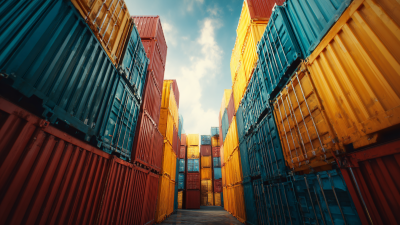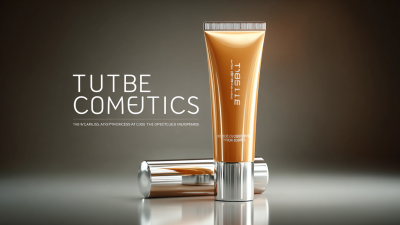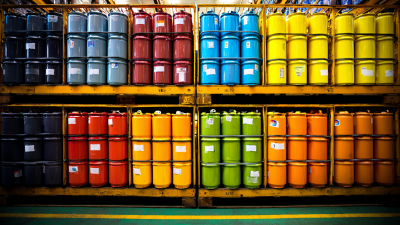
Exploring the Versatility of Tube Containers in Sustainable Packaging Solutions
The rise of sustainable packaging solutions marks a significant evolution within the global packaging industry, as companies increasingly adopt environmentally friendly practices to meet consumer demands and regulatory requirements.

Tube containers not only minimize material usage but also offer a lightweight and durable alternative to traditional packaging methods. Research indicates that sustainable packaging can lead to a 30% reduction in carbon emissions throughout the lifecycle of products. This makes tube containers an ideal choice for various industries including cosmetics, food, and pharmaceuticals, where both performance and sustainability are paramount. By leveraging cutting-edge designs and eco-friendly materials, tube containers continue to demonstrate their adaptability and effectiveness in addressing the environmental challenges faced by manufacturers and consumers alike.
Moreover, the versatility of tube containers is reflected in their ability to cater to diverse product specifications while maintaining an attractive presentation. As businesses increasingly focus on brand value and consumer interaction, tube containers provide an opportunity to enhance user experience through innovative designs that are not only functional but visually appealing. Ultimately, the integration of tube containers into sustainable packaging strategies showcases their pivotal role in reshaping the landscape of consumer products and fostering a more sustainable future.
The Growing Demand for Sustainable Packaging in Today's Market
The demand for sustainable packaging solutions is surging in today's market, resonating with consumers who increasingly prioritize environmental responsibility. A significant growth is observed in the global frozen food packaging market, which is projected to reach a value of $11.38 billion in 2024 and expand further to $17.20 billion by 2032. This trend highlights a broader recognition of the need for sustainable options that can reduce waste and promote eco-friendly practices across various industries, including food service and retail.
Similarly, the flexible packaging market is experiencing dynamic growth, with the value expected to rise from $27.2 billion in 2022 to approximately $39.4 billion by 2030, at a compound annual growth rate (CAGR) of 5.2%. This illustrates a shift towards innovative packaging solutions that marry convenience with sustainability. Furthermore, the solubility in packaging is gaining traction, projected to grow from $3.78 billion in 2024 to $5.65 billion by 2032. As brands navigate this evolving landscape, the versatility of tube containers emerges as a practical solution that can meet both functional and environmental needs, setting a precedent for future packaging methodologies.
Exploring the Versatility of Tube Containers in Sustainable Packaging Solutions
This chart illustrates the increasing preference for various sustainable packaging solutions over recent years, highlighting the versatility of tube containers among consumers. The data reflects the growing demand across different packaging types, including tube containers, biodegradable materials, and reusable packaging.
Innovative Materials Used in Tube Container Design for Sustainability
The usage of tube containers in sustainable packaging solutions is rapidly gaining traction, thanks in large part to the innovative materials being integrated into their design. Manufacturers are increasingly turning to biodegradable plastics and recycled paper for their tube containers, which not only reduce waste but also streamline the recycling process. These materials diminish the environmental impact while maintaining the quality and effectiveness of packaging, making them a viable option for eco-conscious brands.
When considering the sustainability of your packaging, here are a few tips: first, opt for tube containers made from renewable materials such as bamboo fiber or plant-based plastics. These alternatives are not only eco-friendly but can also enhance the product's shelf appeal. Second, explore designs that encourage multiple uses or refills, promoting a circular economy model. Lastly, ensure that your tube container is clearly labeled with recycling information to encourage proper disposal practices among consumers.
By focusing on innovative materials and purposeful design, tube containers are transforming the packaging landscape, offering sustainable solutions that help brands align with eco-friendly initiatives and meet consumer demand for responsible packaging options.
Benefits of Tube Containers in Reducing Plastic Waste and Environmental Impact
The shift towards sustainable packaging solutions is crucial in addressing plastic waste and its environmental impact. Tube containers, particularly those made from fiber-based materials, offer significant benefits in this regard. The beauty industry is increasingly prioritizing eco-friendly options, with research indicating that sustainable packaging could generate a market valued at USD 92 billion by 2024. This trend highlights consumer demand for products that not only perform well but also contribute to reducing plastic pollution.
Furthermore, innovative designs in tube containers are emerging as key solutions to combat plastic waste. By utilizing materials that are recyclable or made from renewable resources, companies can minimize their carbon footprint. For instance, agricultural practices alone accounted for over 37 million tonnes of plastic in food packaging in 2019, showcasing the urgent need for alternative solutions. Imaginative design and new materials in tube containers can play a pivotal role in transforming this landscape, ushering in a circular economy that prioritizes sustainability and responsible consumption.
Exploring the Versatility of Tube Containers in Sustainable Packaging Solutions - Benefits of Tube Containers in Reducing Plastic Waste and Environmental Impact
| Dimension | Metric | Benefit |
|---|---|---|
| Material Used | Biodegradable Plastics | Reduced Environmental Impact |
| Recyclability Rate | Over 60% | Encourages Circular Economy |
| Weight Reduction | 30% Lighter than Glass | Lower Transportation Emissions |
| Waste Reduction | 52% Less Waste | Less Landfill Contribution |
| Durability | High Resistance | Reduces Product Spoilage |
| Consumer Preference | 70% Prefer Eco-Friendly | Increased Market Demand |
Versatile Applications of Tube Containers Across Various Industries
Tube containers have emerged as a versatile solution across various industries, driven by the increasing demand for sustainable packaging. Their unique design allows for a wide range of applications, from cosmetics and personal care products to food and beverages. As industries look for ways to reduce their environmental footprint, tube containers made from recyclable materials offer an attractive alternative to traditional packaging options. For instance, the global composite cardboard tube packaging market is projected to grow from $1.8 billion in 2024 to $3.2 billion by 2034, reflecting a compound annual growth rate (CAGR) of 5.8%. This growth is a testament to the shifting consumer preferences towards eco-friendly and recyclable choices.
Additionally, the insulation paper tube market, valued at $25 million in 2022, is expected to double by 2030, with an impressive CAGR of 8.4% during the same period. This underscores the adaptability of tube containers in specialized applications while catering to the growing trend of sustainable practices. As innovative technologies continue to evolve, the potential for tube containers to serve diverse markets, including electronics and automotive, expands further. This versatility positions tube containers as pivotal elements in the future of sustainable packaging solutions.
Future Trends: Advancements in Tube Container Technology and Eco-Friendliness
The future of sustainable packaging is increasingly intertwined with advancements in tube container technology, which offers a promising alternative to traditional packaging methods. As manufacturers seek to reduce their carbon footprints, innovations in materials such as biodegradable plastics and recycled content are gaining traction. These eco-friendly materials not only enhance the sustainability of tube containers but also appeal to consumers who prioritize environmentally responsible products.
Furthermore, technological developments in design and functionality are pushing the boundaries of tube container applications. For instance, improved sealing techniques and user-friendly dispensing mechanisms ensure that products remain fresh and are easy to use, thereby enhancing customer satisfaction. Additionally, the rise of digital printing technology allows for personalized packaging designs, which can promote brand identity while minimizing waste. As companies continue to invest in research and development, the versatility of tube containers is set to expand, paving the way for a more sustainable future in packaging solutions.
Related Posts
-

Ultimate Checklist for Choosing the Best Tube Containers for Your Business
-

Innovative Approaches to Sourcing the Best Tube Cosmetics for Global Markets
-

Mastering the Art of Tube Cosmetics Application for Flawless Skin
-

7 Essential Tips to Elevate Your Beauty Game with Tube Cosmetics
-

How to Choose the Right Tube Containers for Your Business Needs
-

Revolutionizing Oral Care: Innovative Toothpaste Packaging Solutions for Eco-Conscious Brands






